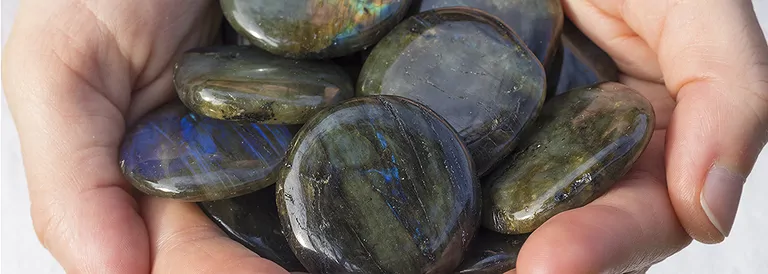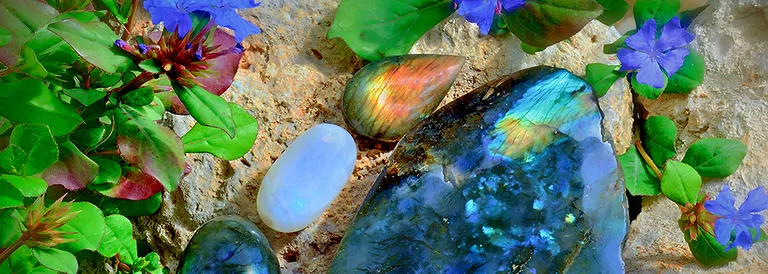
Labradorite - meaning, effect and application
The colorful and dazzling labradorite clearly shows your own goals and plans. With all the activity, it is sometimes not so easy to take a closer look at what is happening and to remain critical despite all the enthusiasm. Labradorite can provide valuable support here: The core of the matter and the meaning of the goals are revealed, illusions fall away, you can look behind things and listen to yourself - perhaps as part of a meditation. Intuition is also strengthened by labradorite. Full of creative ideas and with great enthusiasm, you can devote yourself, disillusioned, to the really important projects.
Mineralogical profile of labradorite
Formula: NaCa[AlSi3O8/Al2Si2O8] + Ba,Fe,K,Mn,P,Sr,Ti + (Cu,Ga,Nb,Ni,Pb,Zn,Zr)
Category: Mineral of the Feldspar family and framework silicates
Labradorite is no longer considered an independent mineral, but is a so-called plagioclase; details can be found below.
Color: white, yellowish, gray, gray-green, brownish to black; colorful play of colors appears on the cleavage surfaces (dark Labradorite) or white with bluish play of colors (white Labrodorite). The play of colors on the surface of labradorite is called labradorescence; see below for details.
Luster: glassy
Crystal system: triclinic
Mohs hardness: 6 to 6.5
Cleavability: perfect
Fracture: uneven, splintery
Localities: Australia, Italy, Finland, Greenland, India, Canada (Labrador), Mexico, Madagascar, Russia, Sweden, Ukraine, USA. The dark Labradorites on the market mostly come from Madagascar, the light Labradorites from India.
Occurrence: primary liquid magmatic from basic to intermediate magma or volcanic formation (dark Labradorite) or magmatic in pegmatites, i.e. coarse-grained deep and gangue rocks (light Labradorite).
One side polished pieces, engravings, jewelry, more labradorite articles at wholesale prices
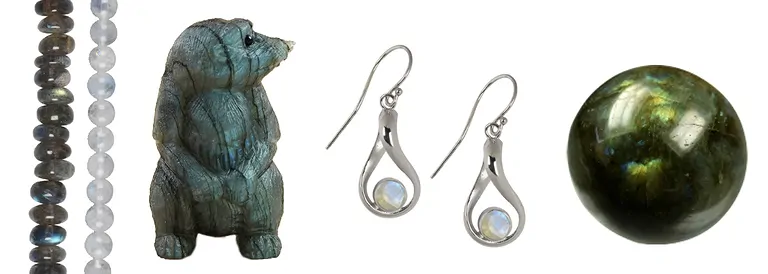
Labradorite, plagioclase and Feldspar
Labradorite is no longer considered a mineral in its own right, but is a so-called plagioclase (soda-lime feldspar). The term "plagioclase" is used to describe mixtures of Albite (NaAlSi3O8) and Anorthite (CaAl2Si2O8), which are assigned to the Feldspar group.
Other well-known representatives of the feldspar group are
Amazonite - K(AlSi3O8)
Moonstone - (K,Na)[AlSi3O8]
Sunstone - Na[AlSi3O8]Ca[Al2Si2O8]
Labradorescence
The most striking feature of a polished labradorite is the iridescent play of colors and the colorful shimmer, which turn what at first glance appears to be an inconspicuous piece into a fantastic, colorful one. This phenomenon is called labradorescence and describes the iridescent play of colors and the colorful shimmer of labradorite. The reason for this fascinating phenomenon lies in the layered structure of the mineral, which creates complex optical effects.
During the Occurrence of labradorite from a homogeneous, hot liquid, different layers were gradually deposited, each with a slightly different chemical composition.
When light strikes the labradorite, it is both absorbed and reflected by the individual segregation layers and also split into the spectral colors. The individual light waves (known as interference) often overlap within the gemstone and either amplify or cancel each other out.
Which of these effects dominates and thus determines the color play of the individual piece depends on the angle of incidence of the light and the thickness of the different layers - this becomes clearly visible when you move a labradorite piece back and forth in your hand, for example. The predominant colors are blue, violet and green, although other colors are occasionally found. In very rare cases, the shimmer covers the entire color spectrum; in this case, the gemstone is called spectrolite.
Tumbled stones, stringed beads, donuts and more labradorite articles at wholesale prices
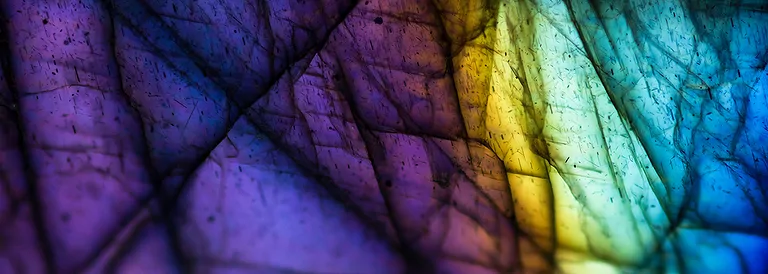
Origin of the name, varieties and synonyms of labradorite
The first labradorites arrived in Europe in the 18th century after they were found on the Canadian peninsula of Labrador in 1770. The Czech missionary Father Adolf found the first pieces there when the Moravians founded numerous settlements on the forest-covered peninsula in the Atlantic. The mineral was given its name "labradorite" in 1832 by the French mineralogist and professor François Bedaunt (1787 - 1850) due to its localities on the Labrador Peninsula. In the 1960s, the colorful, iridescent spectrolite, a rare variety of labradorite, was discovered in Finland (see "Labradorescence").
A third representative of the labradorite group is galaxyt, a shimmering black mineral with tiny speckles of labradorite, which has been on the market since 1995 and is also found in Canada.
The so-called "rainbow moonstone" is a white variety of Labrodorite (white) with a bluish or multicolored shimmer, which also belongs to the Feldspar group, but cannot be mineralogically described as Moonstone. The blue iridescence of rainbow moonstone is usually somewhat darker than that of genuine Moonstone.
Synonyms and trade names of labradorite are anemousite, carnatite, hafnefjordite, labradorite, labratowrite, lynx eye, maulite, mornite, ox eye, radauite, rainbow stone, schiller spar and silicite. A rock known under the trade name "Labrador" has nothing to do with the mineral labradorite; it is a syenite.
Misleading synonyms for the dark Labradorite are (black) rainbow stone and (colorful) flint. The names Northern Lights Stone and Aurora Borealis go back to the legend that the Northern Lights (Aurora Borealis) were once trapped in the mountains of the Labrador coast and were freed by a brave warrior who broke the rock. This is how the aurora borealis can be seen high up in the north today, only a few rays remained and became labradorite.
Order tumbled stones, one side polished pieces and more labradorite articles at wholesale prices
Effect of labradorite
Illusions are part of the spice of life, without them it would often be far too dull and monotonous. But if we indulge in illusions uncritically, lose ourselves in reveries without recognizing them as such, then we run the risk of being brought back down to earth sooner or later! One of the strengths of dark Labradorite is that it initially brings illusions vividly and vividly before our eyes, until we suddenly recognize their true content as pure reflections of light. Creativity and imagination are not impaired, only our realistic view is strengthened.
Labradorite also enhances our memory and our ability to feel emotions more deeply. The effects of labradorite can be experienced particularly well in meditation with the help of a (semi-)polished stone.
White Labrodorite (white) is used in modern gemstone healing to improve sensitivity and body awareness. The memory of dreams is supported by white Labrodorite.
The galaxite variety helps to remember dreams and enhances emotional perception. It facilitates access to a state of emotional contentment. With its play of colors, spectrolite particularly supports the imagination and creativity and strengthens artistic talents.
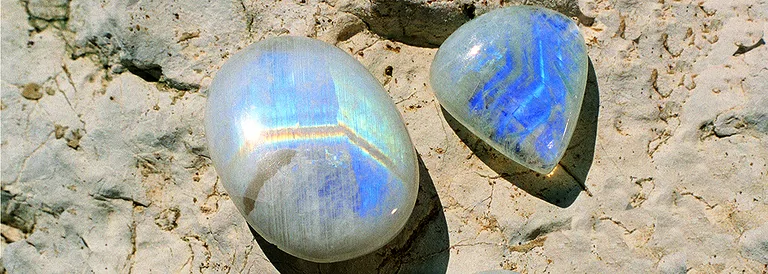
Labradorite as a gemstone
Labradorite is very popular as a cut stone, e.g. for knotting gemstone necklaces or in cabochon cut as a pendant or ring stone. Labradorite must be processed with care, as the gemstone does not tolerate acids, alkalis or galvanic baths. Even cleaning a piece of jewelry in an ultrasonic bath can damage the stone. As labradorite, with a Mos hardness of 6 - 6.5, is softer than quartz (7), for example, labradorite becomes dull and unsightly after a long time due to the omnipresent dust, which also consists of quartz grains. However, with the help of a soft brush, for example, labradorite can easily be restored to its former luster .
